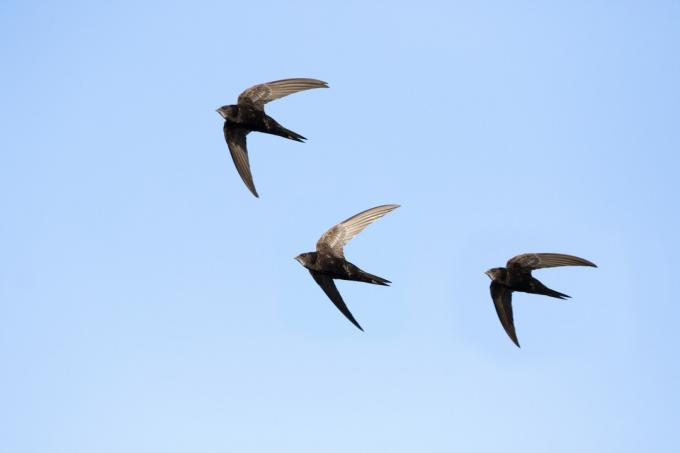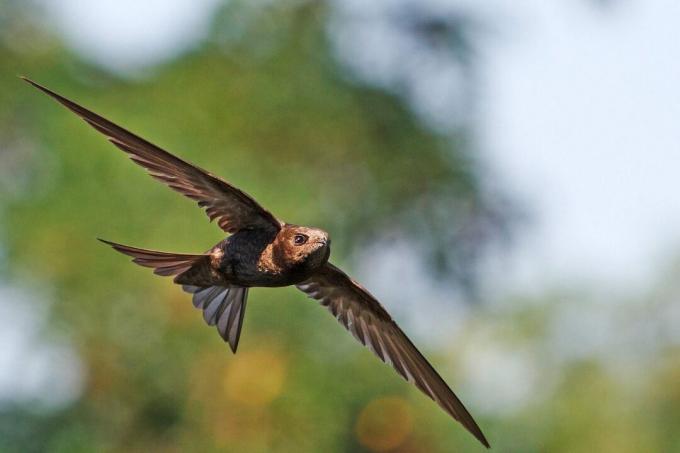How do you distinguish swifts from swallows? What does the perfect nesting box for a swift look like? What should you do if you find a swift? We reveal it in our profile.

If there is a bird that is a master of flight, it is the common swift (apus apus). The bird is built to fly and does practically nothing else. Apart from a brief breeding season, the swift spends its entire life in the air. Even at night, the animals do not land to sleep, but let themselves be lifted by the wind and only fall into a kind of half-sleep. During the breeding season, common swifts can be seen in many places in our area looking for food. The birds fly at breakneck speeds high in the air, above the water surface or between buildings in pursuit of flying insects. Here you can find out how to recognize the sailor by his voice, how to support him in your own garden and much more.
contents
- Common swift: profile
-
How to recognize swifts
- How do swifts differ from swallows?
- How does the swift call sound?
- How do you recognize a baby swift?
- How do you recognize swift eggs?
- What does the perfect habitat for the swift look like?
- Where does the swift build its nest?
- When do swifts breed?
- What does the common swift do in winter?
-
Support swifts: That's how it works
- What do swifts eat?
- Which nest boxes are suitable for swifts?
- Found a swift: what to do?
- How can you provide additional support for the swift?
Common swift: profile
| size | About 16 - 17 cm |
| Weight | About 40g |
| breeding season | May - July |
| lifespan | Up to 20 years |
| habitat | Anywhere there are flying insects |
| food | All kinds of flying insects |
| threats | Severe decline in food and nesting opportunities |
How to recognize swifts
Swifts are quite simply colored birds. Their entire plumage is uniformly dark - with the exception of a light throat patch, which can hardly be seen in flight. And since a common swift lands extremely rarely, identification almost always has to be based on the shape of the body and the flight pattern. The birds mostly hunt in groups and like to perform fast and dangerous-looking flight manoeuvres. They are easily recognized by their forked swallowtail, uniformly dark plumage, and long, narrow, crescent-shaped wings.
How do swifts differ from swallows?
Swifts and swallows are often lumped together. However, these are two very different groups. Nevertheless, the species like to hunt together, making it not always easy for us to tell them apart. However, swifts stand out very well from our two most common swallow species with their uniformly dark underside. Because both the house martin as well as the barn swallow have a light belly. And although swallows also have narrow, tapered wings, they can't compete with the long, crescent-shaped wings of swifts.

How does the swift call sound?
In flight, the common swift can be recognized not only by its shape, but also by its reputation. His voice can often be heard, especially when hunting in larger groups: "Sriii-sriii". The sailor, on the other hand, does not have a specific song.
This is how the call of the swift sounds:
How do you recognize a baby swift?
You will probably rarely see a freshly hatched swift, as the little ones are raised in caves or crevices. The young birds capable of flying hardly differ from the adult animals. Their plumage is only lined with a little light and therefore does not appear quite as dark as that of the parents. But even the young animals can only rarely be observed sitting down and this subtle difference is difficult to recognize in flight.
How do you recognize swift eggs?
The swift's eggs are slightly longer than a typical bird's egg. The females lay two to three white, dull eggs per season. The nest inside the burrow is made of fine stalks and feathers that the parents fish out of the air or pluck in flight. The rather loose and untidy arranged nesting material is then glued together with fast-hardening saliva.

What does the perfect habitat for the swift look like?
Common swifts choose their habitat primarily based on the food supply. An abundance of flying insects is a must. The sailors are not very choosy and hunt over fields and meadows as well as in villages and towns. Preference is also given to areas with large bodies of water, over which the hunters can find enough insects even when it rains.
Where does the swift build its nest?
Originally, the swifts were rock breeders and lived in crevices. Later, they became followers of culture and moved closer and closer to human settlements. Even today, most of them breed in building facades with holes and in crevices in walls. However, these nesting opportunities continue to decrease, since modern facades and renovated buildings usually no longer offer any space for the swifts. Occasionally, the swifts can also be observed nesting in tree cavities.
When do swifts breed?
Common swifts start breeding in May. Incubation can last up to 27 days. This is the only time in their lives that sailors spend most of their time sitting down. Partners take turns incubating and foraging the rest of the time. After hatching, the young birds are initially featherless, blind and helpless. In the next few weeks, their parents will provide them with tons of flying insects. After about 40 days they are mature enough to leave the nest. Then life in the air begins directly, because as soon as the young animals have flown, they only sleep during the flight, like the adult animals.

What does the common swift do in winter?
Common swifts are only present in their breeding grounds for a little over three months. Even the late departing birds are already on their way south in August. The swifts fly to Africa and migrate along the Atlantic coast to their wintering grounds. And even after arrival, many swifts follow the rains to meet their demand for insects. In the spring, between April and May, the sailors return to us.
Support swifts: That's how it works
The population of common swifts is slowly but surely declining. The renovation of old buildings in particular is causing the disappearance of well-known nesting sites. And the loss of insects is also causing problems for the hunters. You can find out here how you can support the common swift in your own home.
What do swifts eat?
Swifts are pronounced insect eaters. They eat mosquitoes, moths, aphids and a variety of other flying insects. They are not picky about it. If the food supply becomes scarce due to the weather, the sailors follow the rain over long distances and leave everything else behind. In such a case, young animals can go up to 14 days without food by falling into a kind of "hunger sleep" and greatly reducing their energy requirements.

Which nest boxes are suitable for swifts?
In view of the declining nesting opportunities, swifts are increasingly dependent on artificial nesting aids. With a special nesting box, you too can easily create a home for the sociable sailors. Such a box for swifts should be wider than it is high - at least 28 centimeters wide and 17 centimeters deep - and have an oval, transverse entrance hole of 64 x 32 millimeters. Since swifts often breed in colonies, it makes sense to attach several boxes at the same time. Further tips on the right wood, location and cleaning can be found in our special article on the topic "Build your own nest box“.
tip: Alternatively, so-called nesting stones, which can be installed directly in the house wall or in a wall, are also suitable for swifts.
Found a swift: what to do?
If you find a young swift outside the nest, you need to check two things: What is the condition of the bird? And how far has it developed? If you find a nearly adult bird, first see if it will fly away on its own, perhaps just recovering from a failed flight attempt. On the other hand, if the bird is still very small or has no feathers, first try to locate the nest and carefully release the young bird. If you cannot find the nest or have found an injured or traumatized bird, contact Wildvogelhilfe immediately. The rearing of a young bird is more complicated than you think and can go wrong very quickly for laypeople.
When handling found swifts, watch out for possible swift louse flies. These are parasites that nest in the feathers of swifts or swallows. The small animals can also sting a person, which is accompanied by pain and itching, but is otherwise not harmful.

How can you provide additional support for the swift?
Due to the exclusive search for food in flight and the fact that the gliders spend the winter in Africa, a classic winter feeding is not possible. Nevertheless, you can promote the food supply of the artful flyers - the motto here is: insect protection is bird protection. When shopping, you should therefore pay attention to organic cultivation methods that promote the occurrence of insects. Also avoid insect-toxic sprays in your own garden and rely on sustainable alternatives. You can go one step further by creating a beneficial insect meadow. Our Plantura beneficial insect magnetoffer you the opportunity to create a paradise for insects and other small garden visitors.

Plantura beneficial insect magnet
Annual & perennial species for beneficial insects
such as birds, bees & Co, easier to care for
Blossom dream in bed, pot & window box
Other bird species are also happy about you bird friendly garden. With a little patience, you can observe a whole range of garden birds in your home - for example the Serin or the tree sparrow.
...and receive concentrated plant knowledge and inspiration directly in your e-mail inbox every Sunday!



